We hightailed it out of Yangshuo and jumped on the overnight train to Chongqing, in Western China. We got on the train at 1PM and arrived in Chongqing the next morning, so we had plenty of daylight hours to enjoy the view…and what a view it was! Guangxi province has an incredible landscape…full of the same karst formations we saw in Yangshuo.
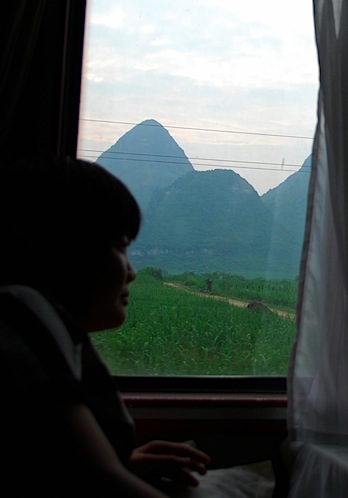
This was our first experience in China traveling “with the people,” and we saw many Chinese families en route to their various destinations.
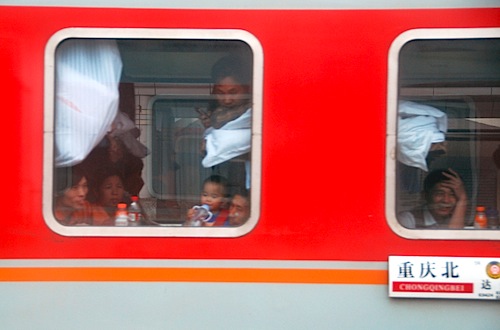
We shared our cabin with a man of 40 or so who was taking his ailing uncle to Chongqing for treatment. His tenderness towards his uncle (who he told me was “like a parent” to him) reminded me of the best aspects of Chinese culture (respect towards the elderly, filial piety, etc.), at a time when I was still stinging from experiencing its worst in Yangshuo.
You’ve probably never heard of Chongqing, and it’s not on most travelers’ radars as a destination (other than as the launching point for boat trips down the Yangzi). Actually, we wouldn’t have considered Chongqing as a stop on our trip through China, except that my aunt (Xiao Jo Ma) has an apartment there, and she insisted that we take advantage of it.
But hey, World Out There, remember that name, “Chongqing.” You will undoubtedly hear about it in the coming years. The Chinese government is pouring tons of money into this city, as an experiment in making the interior of China as successful as it’s East Coast. It’s also a way to improve the economic situation of millions of rural inhabitants by providing job opportunities. The building boom is on steroids here, a situation that is well documented in this video: http://current.com/items/88938803_city-on-steroids.htm
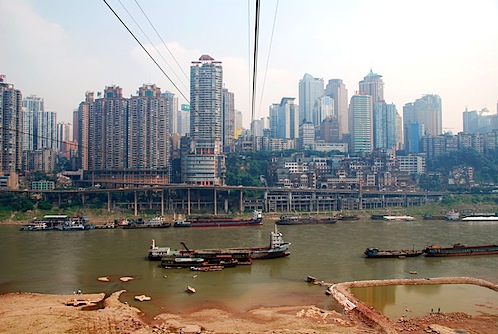
Chongqing’s Jiefangbei district, seen from across the Jialing River.
Chongqing is the fastest-growing city in the world, as rural populations flock to the city for job opportunities. Some estimates put the population at 40 million. Let that sink in for a minute: 40 MILLION. For reference, that is almost twice the number of people in the entire country of Australia. There are an estimated 1200 people moving to the city EACH DAY.
Even though my brother is the one in the family interested in urban planning, I couldn’t deny that Chongqing is a fascinating place. The scale of the city is hard to grasp, though Chongqing’s amazing urban planning museum does a good job of showing you China’s ambition:
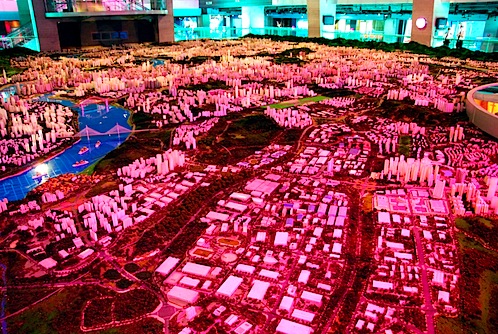
A model of Chongqing in 2010. It is hard to capture the scale here, but for reference, there are two people standing in the upper right hand corner of the photo.
Chongqing’s urban planning museum is brand new and super slick, but we couldn’t help but notice that many of the interactive computer models were broken, and letters were already falling off the displays…a poetic metaphor for the future of Chongqing.
Indeed, it seems that Chongqing’s appetite for the new and bigger is insatiable…we noticed many recently-built buildings that were already starting to fall into disrepair: perhaps poorly and hastily-built, their decay advanced by neglect. The message seems to be: rather than maintain an old building, build a new one.
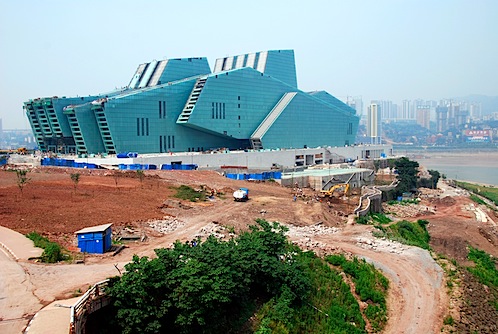
The enormous Opera House under construction in Chongqing. We think it looks like a tank.
Chongqing is a fascinating mix between the old and the new China. “Bang bang men” carry huge loads of goods on their backs up and down multi-level highrises. Former farmers sweep away construction debris with homemade bamboo brooms. These scenes seem incongruous somehow with the rapid modernity that Chongqing is currently experiencing.

Bang-bang man with a heavy load.
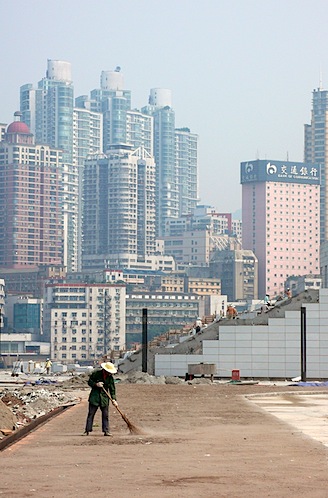
Construction worker sweeping debris with a bamboo-stick broom.
Of course, the price of all this “progress” is reflected in the environment. The air quality in Chongqing is absolutely horrible. We did not see the sun a single day we were here. It is clear that the environment cannot continue to sustain this level of development.

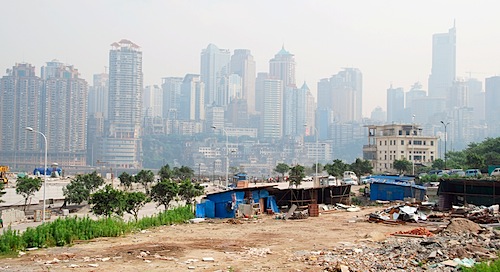
This is Chongqing.
So this is what I mean when I say, “the China we are seeing now may never exist again.” With 1200 people moving into the city each day, rapidly leaving their old, rural lives behind…China is forging ahead and not looking back. I say this without nostalgia…there is little doubt that these peoples’ lives are improved economically and it is unfair to expect them to preserve some idealized way of life for a Western audience. But as the narrator in the video I linked to above asks, when you look at the effect that this development has on the earth, is this really progress?
Your insights and stories continue to be absolutely incredible, Hope. Thank you so much for sharing.
Great post. The fast disrepair you see in new construction projects in China are nothing new. A friend of ours explained that in China, everything is designed with planned obsolescence in mind. How else to employ 1.2 billion people if you don’t have constant construction and reconstruction throughout the country?
thanks for your comments, tya and lauren! lauren, you make a great point. we saw tons of empty highrises on our boat trip down the 3 gorges…there is definitely something tricky happening so that China’s economy can hit that magical 8% growth they seem to have year after year.